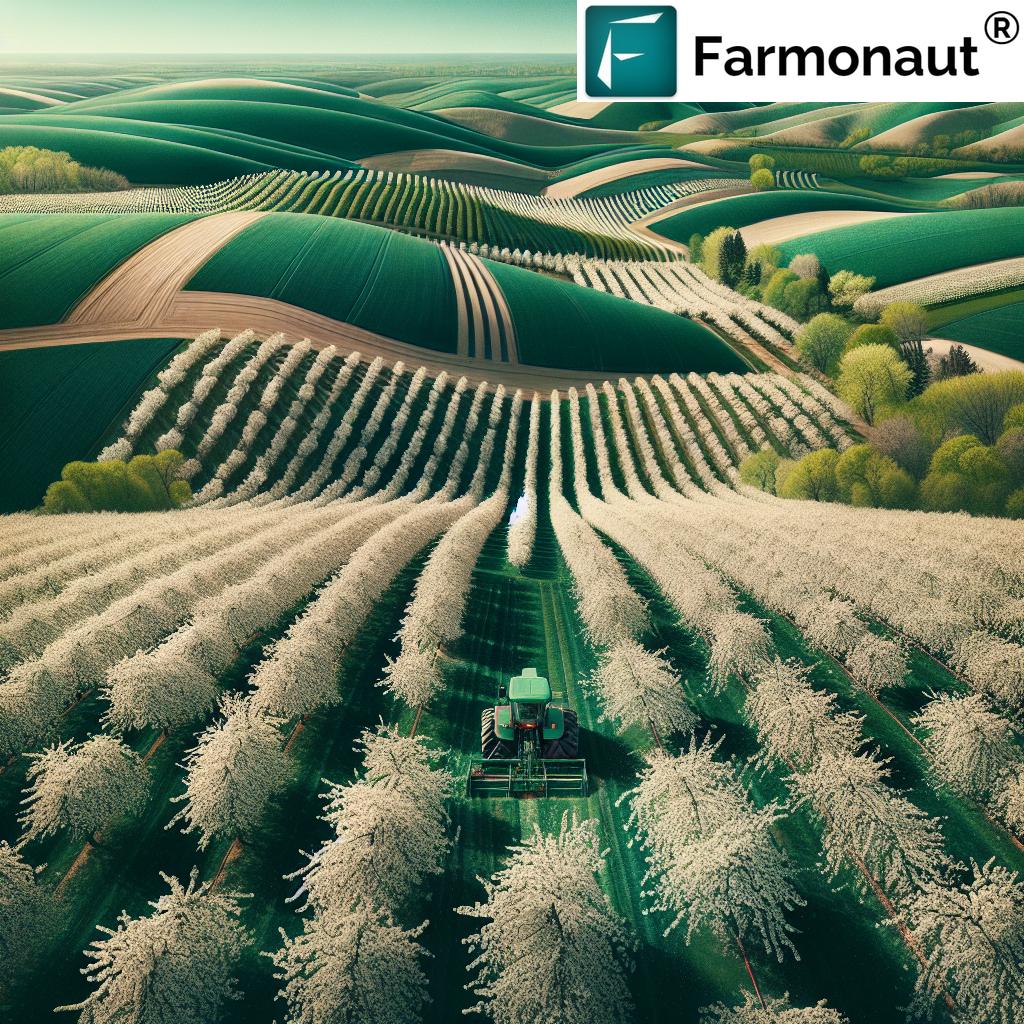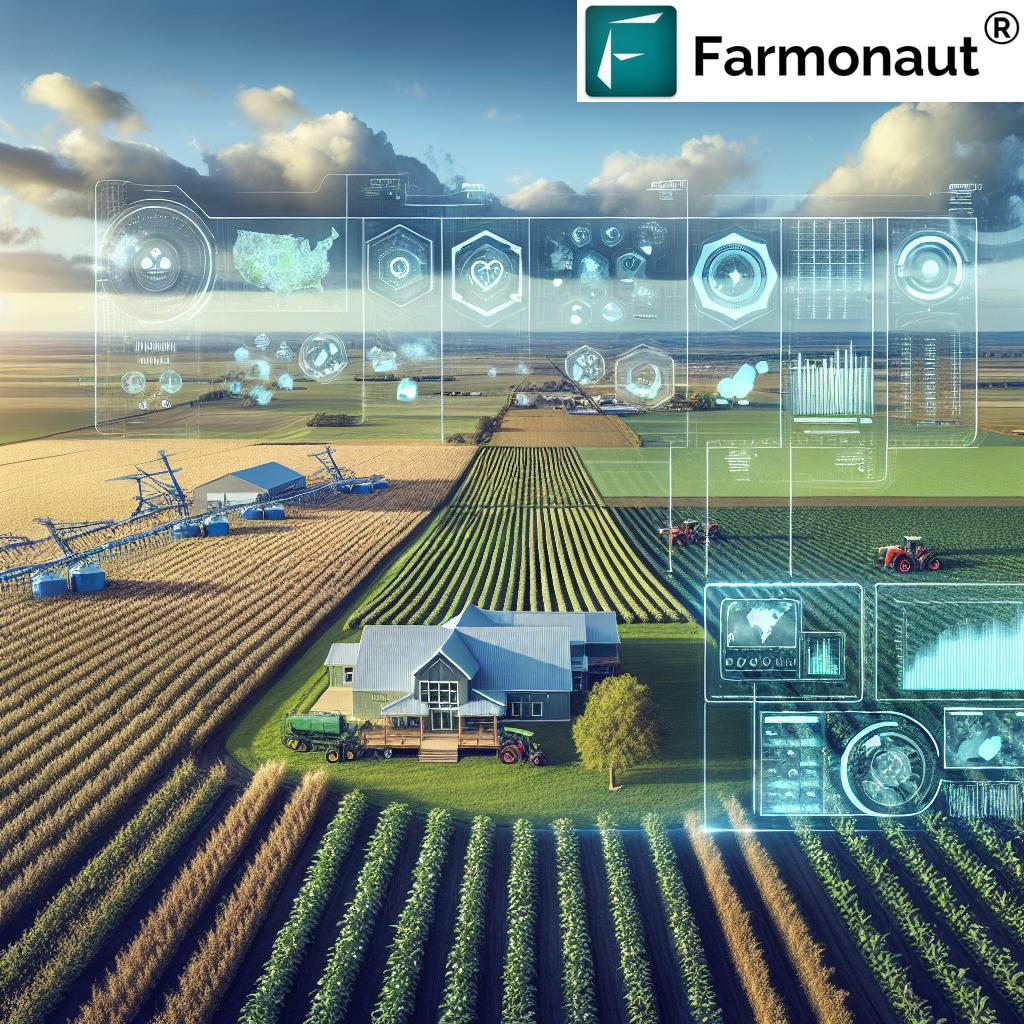Best Drip Irrigation Emitters & Benefits in Florida: Optimizing Water Use & Technology in 2025
Drip Irrigation: Revolutionizing Water Management in Florida Agriculture – 2025 Focus
“Florida drip emitters can reduce water usage by up to 50% compared to traditional sprinkler systems in 2025.”
Table of Contents
- Introduction: Why the Best Drip Irrigation Emitters Matter in Florida
- Understanding Drip Irrigation: Technology & Advantages
- Drip Irrigation in 2025: The Evolving Florida Context
- Selecting the Best Drip Irrigation Emitters for Florida in 2025
- Comparison Table of Drip Irrigation Emitters for Florida (2025)
- Benefits of Adding Drip Irrigation to Existing Sprinkler System in Florida
- How Farmonaut Empowers Water Management with Satellite Technology
- Video Insights on Irrigation Trends and Smart Water Use
- Future Outlook: Drip Irrigation Technology & Florida’s Agriculture
- Frequently Asked Questions (FAQ)
- Conclusion: Drip Irrigation and the Future of Florida Farming
Introduction: Why the Best Drip Irrigation Emitters Matter in Florida
Florida’s agricultural sector continues to evolve rapidly amidst changing climate patterns, increasing water demands, and the growing importance of sustainable farming methods. As we move into 2025 and beyond, efficient irrigation methods have become a critical pillar in ensuring resilient yields, optimizing water use, and positioning Florida as a leader in smart agricultural practices.
One technology that particularly stands out is drip irrigation. The benefits of drip irrigation in Florida are now more relevant than ever, as it enables precise, slow, and localized delivery of water directly to the roots of plants, minimizing waste, promoting soil health, and enhancing yields. Advances in drip irrigation emitters—with pressure-compensating, multi-outlet, and adjustable flow features—combined with strategic integration into traditional sprinkler systems, are revolutionizing water management across the state.
“Integrating drip emitters into Florida landscapes can boost irrigation efficiency by 30%, promoting smarter water technology.”
Understanding Drip Irrigation: Technology & Advantages
The Core Principles of Drip Irrigation
Drip irrigation involves delivering water directly to the root zones of plants via a network of tubes, pipes, and emitters. Unlike traditional sprinkler systems that spray water across large areas, the drip approach minimizes evaporation and runoff by applying water slowly and precisely. This localized technique not only helps in reducing overall water use, but also optimizes nutrient uptake for crops.
Why Florida’s Climate Makes Drip Irrigation Essential
Florida is characterized by hot, humid summers and occasional droughts, resulting in unique challenges for water conservation. Moreover, state-level regulatory requirements and resource constraints are pushing farmers and growers to seek more efficient irrigation technologies. By limiting water application to where it’s needed most, drip systems can help farmers:
- Significantly conserve water—vital in a state prone to drought cycles.
- Reduce weed growth by limiting water distribution to non-target areas.
- Lower soil erosion and decrease the risk of fungal diseases caused by excessive foliage moisture.
- Maintain consistent soil moisture during hot spells and unpredictable rainfall.
- Comply with state regulatory emphasis on water-saving practices.
The Advantages of Drip Irrigation for Florida in 2025
The adoption of drip irrigation and the careful selection of the best drip irrigation emitters present several key benefits:
- Water Savings: By minimizing evaporation and runoff, drip systems can achieve up to 50% reduction in water use compared with traditional sprinklers.
- Improved Plant Health: Targeted and consistent water delivery reduces stress on crops, leading to higher yields and improved nutrient uptake.
- Reduced Disease and Weeds: Less water on foliage means lower fungal disease risk. Focused watering also curbs weed growth, minimizing herbicide use.
- Enhanced Flexibility: Farmers can adjust emitter flow rates for different crops or plant stages, ensuring optimal growing conditions throughout the season.
- Efficient Fertilizer Usage: Fertilizers applied via drip systems reach the root zones directly, enhancing efficiency and reducing environmental runoff.
Watch: How Satellites and AI Revolutionize Water Management in Farming | Precision Agriculture with NDWI
Drip Irrigation in 2025: The Evolving Florida Context
Florida’s farming sector is not only one of the most productive in the United States but also among the most water-intensive due to its year-round growing season and diversity of crops. In 2025, technology advancements have made drip irrigation more accessible, flexible, and efficient, enabling farmers to respond proactively to climate changes and water restrictions.
With increasing water demands and tighter environmental regulations, integration of drip systems with existing sprinkler networks has emerged as a strategic and sustainable choice. This approach provides growers with the flexibility to cover the full spectrum of crop requirements while optimizing operational costs and environmental impact.
State and local water management agencies also support the transition towards drip irrigation with incentive programs and technical assistance, amplifying the benefits for those selecting the best drip irrigation emitters tailored to Florida’s unique soil, climate, and crop needs.
Watch: Florida Fertilizer Ban 2025 ? 7 Rules to Save Indian River Lagoon & Stop Algae Blooms!
Selecting the Best Drip Irrigation Emitters for Florida in 2025
Choosing the right emitters is essential for maximizing the benefits of drip irrigation in Florida. Numerous factors must be considered, including crop types, field topography, water quality, and integration with existing systems.
Top Recommended Drip Irrigation Emitters in Florida
In 2025, farmers are increasingly favoring pressure-compensating emitters, thanks to their ability to deliver a consistent flow rate regardless of terrain or pressure fluctuations—ensuring that every plant gets just the amount of water it needs.
- Pressure-Compensating Emitters: Best for uneven fields, orchards, and sloped lands. These ensure water is distributed uniformly across the landscape even if the pressure is not the same everywhere.
- Multi-Outlet Emitters: Ideal for watering grouped plants efficiently, such as citrus groves, berry patches, or raised vegetable beds. They save on installation time and materials.
- Adjustable-Flow Emitters: Offer flexibility to alter the flow rate for specific plants or sections of the field. This is critical when integrating drip with existing sprinkler systems serving diverse crop types.
- High-Clogging-Resistance Emitters: Designed to perform well with lower-quality water or where debris is a concern, reducing maintenance needs over time.
Pro Tip: When adding drip irrigation to existing sprinkler systems in Florida, focus on emitters that have excellent integration ratings and offer reliable water savings, especially in areas with water restrictions or sandy soils prone to runoff.
Comparison Table of Drip Irrigation Emitters for Florida (2025)
Below is a detailed comparison of the best drip irrigation emitters suited for Florida’s landscape and climate in 2025. This information can help farmers make strategic and informed choices for sustainable water management.
| Emitter Model | Flow Rate (GPH, est.) |
Pressure Range (psi, est.) |
Clogging Resistance (1-5 rating) |
UV Resistance | Suitable Crops/Landscapes | Estimated Cost per Emitter (USD) | Integration Ease with Sprinkler Systems (1-5) | Water Savings Potential (% vs. traditional systems) |
|---|---|---|---|---|---|---|---|---|
| PC-Plus Pressure Compensating | 0.5, 1.0, 2.0 | 10–55 | 5 | Yes | Citrus, berries, uneven and sloped fields | $0.45–$0.55 | 5 | Up to 50% |
| Multi-Outlet Drip Manifold | 2.0–8.0 | 15–50 | 4 | Yes | Orchards, grouped vegetable beds, large pots | $2.50–$4.00 | 4 | 40–45% |
| Adjust-a-Flow Dripper | 0-10 (adjustable) | 10–60 | 4 | Yes | Floriculture, nurseries, raised beds, home landscapes | $0.70–$1.00 | 5 | Up to 45% |
| XP Emitter (Anti-Clogging) | 1.0 | 15–40 | 5 | Yes | Microfarms, sandy soils, reclaimed water use | $0.90–$1.10 | 4 | Up to 50% |
| DeepRoot Inline Emitter (Tubing) | 0.6–1.6 | 10–50 | 4 | Yes | Row crops, cover crops, vegetable farms | $0.09–$0.14 | 3 | 35–40% |
Table: Comparison Table of Drip Irrigation Emitters for Florida (2025). Includes focus keyword in table caption & ALT text for SEO benefit.
Watch: Peru $24B Irrigation Boom 2025 ? 22 Megaprojects & AI Precision Farming Turbo-Charge Exports
Benefits of Adding Drip Irrigation to Existing Sprinkler System in Florida
Many agricultural operations in Florida already use expansive overhead sprinkler systems. For these farmers, making the switch to 100% drip irrigation may seem daunting due to cost or system complexity. Instead, many are now integrating drip irrigation with their existing sprinkler setups—gaining the best of both worlds. Here are the proven advantages of this hybrid approach:
- Targeted Watering for High-Value Crops: Drip can be used exclusively for crops or zones that require precise moisture levels or root zone targeting (e.g., citrus, berries, orchards, nurseries).
- Continued Coverage for Row and Cover Crops: Sprinklers remain for crops, ground cover, or field areas where broadcast watering is preferred.
- Water Savings and Efficiency Gains: Reducing sprinkler run-times by switching zones to drip can average 30% increases in efficiency and up to 50% water use reduction on targeted blocks.
- Lower Disease and Foliage Issues: With less water applied overhead, plants are less prone to diseases caused by wet leaves.
- Operational Flexibility: Drip systems work best in dry spell (drought) conditions, while sprinklers can be operational in wetter times, controlled via smart sensors and irrigation scheduling tools.
- Ease of Integration: Many of the best drip irrigation emitters are designed for seamless compatibility with traditional sprinkler infrastructure, reducing the need for extensive re-plumbing.
Maximizing ROI on Integration in Florida
The strategic choice to integrate drip irrigation with existing sprinkler systems results in lower energy costs, reduced water bills, and improved soil health and fertility—all vital as Florida continues to evolve amidst increasing climate and regulatory challenges.
Watch: France Water Crisis 2025 ? 7 Smart Fixes—Satellite Leak Alerts & AI Irrigation Saving Farms
How Farmonaut Empowers Water Management with Satellite Technology
Effective irrigation management in 2025 goes beyond selecting the best hardware. Real-time data, precision tools, and AI-driven insights allow farmers to predict, plan, and optimize water usage for every crop and weather pattern. At Farmonaut, our mission is to democratize access to advanced satellite-driven irrigation and sustainability insights—making smart agriculture affordable and accessible.
- Satellite-Based Monitoring: Farmonaut’s multispectral satellite imagery reveals real-time crop health, soil moisture, and water stress—enabling growers to fine-tune irrigation schedules and maximize yield. Optimize fertilizer application and identify problem areas before issues escalate.
- AI-Driven Advisory with Jeevn AI: Our Jeevn AI system delivers instant, tailored strategies based on satellite data—recommending the optimal timing and method for irrigation to enhance efficiency and sustainability.
- Environmental Impact & Water Use Tracking: Track the carbon footprint and environmental impact of water use in agriculture, helping farms comply with regulations and support climate-smart farming practices.
- Blockchain Traceability: Ensure the transparency of crop production and input use—essential for Florida farmers who wish to demonstrate responsible water and resource management. See more: Farmonaut Product Traceability
- API Integrations: Developers and businesses can seamlessly integrate satellite-based irrigation and water analytics into their own systems via our API and API Developer Docs.
-
Mobile and Web Accessibility: Access irrigation, crop, and soil data from anywhere, anytime via the
 or download from Google Play
or download from Google Play  and iOS
and iOS 
- Large-Scale and Precision Farm Management: Monitor vast acreage remotely and manage irrigation with unparalleled efficiency. Learn more about our large-scale management tools here: Farmonaut Large Scale Farm Management.
- Fleet Management and Operational Efficiency: Streamline your farm logistics with Farmonaut Fleet Management, optimizing resource and water use across large agricultural operations.
- Crop Loan & Insurance Readiness: Use satellite-verified records of irrigation efficiency and water management for documentation, improving access to crop loan and insurance in Florida.
Our platform’s modularity ensures everyone—from small-scale farmers to large agribusinesses—can benefit from drip irrigation management that’s data-driven and forward-thinking.
Watch: Regenerative Agriculture 2025 ? Carbon Farming, Soil Health & Climate-Smart Solutions | Farmonaut
Video Insights on Irrigation Trends and Smart Water Use
-
Malawi Irrigation Tech 2025 | 3 Solar-Pump Secrets That Triple Yields in Mzimba!
-
Smart Farming Future : Precision Tech & AI: Boosting Harvests, Enhancing Sustainability
-
Smart Farming Future: Precision Tech & AI Boosting Harvests, Enhancing Sustainability
Future Outlook: Drip Irrigation Technology & Florida’s Agriculture
As Florida agriculture faces intensifying climate variability, tightening water restrictions, and ongoing economic pressures, drip irrigation innovations—especially when combined with cutting-edge AI and satellite-powered analytics—will define the future of sustainable farming in the state.
Key trends shaping irrigation in Florida 2025 and beyond:
- Precision & Digital Integration: Real-time data and AI-based predictions radically enhance irrigation timing, water distribution, and system maintenance.
- Sustainability & Smart Compliance: Integrated water management tools help farms track, report, and optimize for lower carbon footprint and sustainability standards.
- Resource Diversification: More farms will mix sprinkler and drip irrigation for tailored crop solutions, supporting various soil types and plant needs.
- Resilience Against Climate Change: Advanced emitters and integration capabilities ensure systems remain reliable even in periods of drought or extreme weather.
- Innovation in Financing & Resource Access: Satellite-based documentation will increasingly support crop loans, insurance, and regulatory reporting.
- Adaptability for All Scales: Whether managing a small nursery or a vast processing plantation, scalable, modular systems cater to every farmer’s unique needs.
As industry and technology leaders, we at Farmonaut remain committed to equipping Florida growers with the advanced tools and insights necessary for flourishing, sustainable yields and resource stewardship.
Watch: France Water Crisis 2025 ? 7 Smart Fixes—Satellite Leak Alerts & AI Irrigation Saving Farms
Frequently Asked Questions (FAQ): Drip Irrigation Emitters and Water Management in Florida
Q1: What are the benefits of drip irrigation in Florida compared to sprinklers?
Drip irrigation conserves up to 50% more water, reduces runoff, lowers weed and disease risk, and delivers nutrients and moisture directly to plant roots. For Florida’s hot, humid climate and water regulations, these benefits are both economic and environmental.
Q2: Can I add drip irrigation to my existing sprinkler system?
Yes! Adding drip irrigation to existing sprinkler systems is common in Florida. Many modern emitters are designed for seamless integration, helping farmers target water delivery for high-value plants while reserves sprinklers for broader field coverage.
Q3: What are the best drip irrigation emitters for sandy Florida soils?
For sandy or less cohesive soils, select pressure-compensating and anti-clogging emitters that ensure uniform flow. The PC-Plus Pressure Compensating and XP Emitter models stand out for such conditions.
Q4: How do I know how much water my crops need with drip?
Use soil moisture sensors and satellite monitoring platforms like Farmonaut to track water levels, crop health, and optimize irrigation schedules for maximum efficiency.
Q5: What is the cost difference between drip and traditional irrigation systems?
Drip systems may cost more upfront ($0.09–$4.00 per emitter), but rapid ROI comes from savings in water, fertilizer, energy, and reduced crop loss due to disease.
Q6: Can I automate drip irrigation in Florida?
Absolutely. Drip irrigation lends itself perfectly to automation with smart controllers, sensors, and even AI-based advisory systems (like Farmonaut Jeevn AI) to tailor schedules and optimize flow based on weather and soil data.
Q7: How does drip irrigation help with Florida’s strict water usage regulations?
Drip systems align with state regulations favoring water conservation, efficient usage, and sustainable agricultural practices. Using drip helps comply with legal requirements while promoting sustainability.
Conclusion: Drip Irrigation and the Future of Florida Farming
The best drip irrigation emitters—when combined with evidence-based integration into existing sprinkler systems—represent a true paradigm shift for agriculture in Florida as we advance into 2025 and beyond. Drip irrigation stands not only as the most sustainable, strategic, and efficient method for water management, but as a transformative technology for every Florida farmer seeking to enhance yields and promote responsible land stewardship.
Our commitment at Farmonaut is to ensure every grower has access to world-class satellite-powered insights, AI-driven recommendations, and seamless digital tools that optimize irrigation and resource use. As you make your decision about integrating drip irrigation emitters and planning for the future, remember: efficient water management is not just an option but the best investment in the sustainability and resilience of Florida’s agricultural landscape.
Ready to elevate your farm’s water technology for 2025? Explore
Farmonaut Web App |
Large Scale Farm Management |
Traceability Solutions
to harness the power of precision irrigation management today.
Feel free to reach out via our API or mobile applications for integrated, real-time field monitoring and advisory, ensuring your Florida farm remains ahead of the curve—now and well into the future.
Join us in revolutionizing water management in Florida – and let drip irrigation empower your next harvest.












